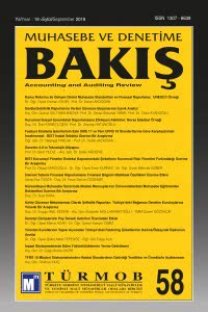TÜRKİYE’DE FAALİYET GÖSTEREN BAĞIMSIZ DENETİM ŞİRKETLERİNİN DENETİM KALİTESİ GÖSTERGELERİNE UYUMU ÜZERİNE BİR ARAŞTIRMA
İşletmelerin faaliyet dönemlerine ilişkin yayımladıkları finansal tabloların ilgili kullanıcılar tarafındandoğruluğunun ve kalitesinin öneminin ortaya çıkmasıyla bağımsız denetim faaliyeti daha önemli halegelmiştir. Önemli muhasebe skandalları ile karşılaşılması, bağımsız denetim şirketleri ve denetim faaliyetleriile ilgili birçok eksiklik olduğunu göstermiştir. Devam eden süreçte denetim kalitesinin ölçümüiçin çalışmalar yapılmaya başlanmıştır. Bu çalışmalar birçok ülke ve yetkili kuruluşları tarafındandenetim kalitesinin ölçülebilmesi için nicel göstergeler önerilmesi ile gerçekleşmiştir. AraştırmadaPCAOB tarafından yayımlanan denetim kalitesi göstergeleri kullanılmıştır. PCAOB 2015 yılında üçana bölümde toplam 28 denetim kalitesi göstergesi yayımlamıştır. Bu doğrultuda, çalışmada denetimkalitesi göstergeleri ile ilgili hükümlerin Türkiye’de faaliyet gösteren denetim şirketleri tarafındankullanılma durumu tespit edilmeye çalışılmıştır. Anket sonuçlarına göre ise 18 denetim kalitesi göstergesininuyumunun yüksek oranda gerçekleştiği tespit edilmiştir. Denetim şirketi türüne göre yapılankarşılaştırmalarda da uluslararası ağa dâhil olan şirketlerle, sadece ulusal düzeyde olan şirketler arasındabirçok gösterge uygulaması bakımından farklılık tespit edilmiştir. KKS 1 ile uyumlu olması vehali hazırda kullanılması nedeniyle ve diğer ülkelerdeki ortak kullanılan göstergeler ve denetim şirketitürlerine göre değerlendirme yapıldığında, 16 denetim kalitesi göstergesinin Türkiye’de uygulamayakonulabileceği önerilmektedir.
Anahtar Kelimeler:
Bağımsız Denetim, Denetim Kalitesi, Denetim Kalitesi Göstergeleri, Kalite Kontrol Standardı 1
A RESEARCH ON COMPLIANCE AUDIT QUALITY INDICATORS OF THE INDEPENDENT AUDITING FIRMS IN TURKEY
Independent audit activity has become more crucial with the emergence of the importance of the accuracyand quality of the financial statements published by the companies regarding their activity periodsfor the relevant users. The occurrence of significant accounting scandals demonstrate that there aremany deficiencies in independent audit firms and their audit activities. In the ongoing process, studieshave been started to measure audit quality. These studies were carried out by the proposing quantitativeindicators to measure the quality of the audit conducted by the authorized institutions of manycountries. In this research are used audit quality indicators published by PCAOB. PCAOB published atotal of 28 audit quality indicators in three main sections in 2015. In the study, accordingly, it was triedto determine whether the adjustments on audit quality indicators are used by audit firms in Turkey.According to the survey results, it was concluded that the compliance of 18 audit quality indicatorswere used at a high rate. The difference was found out in terms of many indicator applications betweencompanies in the international audit network and only at national level companies in comparisonsbased on the types of audit firms. When common indicators in other countries and analysis based ontypes of audit firms are taken into consideration, it is suggested that 16 audit quality indicators canbe put into practice in Turkey as they are compatible with ISQC 1 and are currently used by variousaudit firms.
___
- Referans1 Alpar, R. (2017). Çok değişkenli istatistiksel yöntemler. Beşinci Baskı, Ankara: Detay Yayıncılık.
- Referans2 Bedard, C. J., Jonhstone, M. K. ve Smith, F. E. (2010). Audit quality indicators: a status update on possible public disclosures and insights from audit practice. American Accounting Association, 4(1), C12-C19.
- Referans3 Bozdoğan, T. (2014). Bağımsız denetimde kalite kontrol. Ankara: Detay Yayıncılık.
- Referans4 DeAngelo, L., E. (1981). Auditor size and audit quality. Journal of Accounting and Economics, 3, 183-199.
- Referans5 Federation of Europe Accountants – FEE. (2016). Overview of audit quality indicators initiatives.
- Referans6 Gendron, Y., Suddaby, R. ve Helen, L. (2006). An Examination of the ethical commitment of professional accountants to auditor independence. Journal of Business Ethics, 64(1), 169-193.
- Referans7 ISB - Independent Standards Boards (2000). A conceptual framework for auditor independence.
- Referans8 Kamu Gözetimi Kurumu, Kalite Kontrol Standardı 1 (KKS 1).
- Referans9 Palmrose, Z. (1988). An analysis of auditor litigation and audit service quality, The Accounting Review, 64(1), 55-73.
- Referans10 PCAOB. (2015). Concept release on audit quality indicators
- Referans11 Titman, S. ve Trueman, B. (1986). Information quality and the valuation of new ıssues. Journal of Accounting and Economics. 8(2), 159-172.
- Referans12 Tuan, A.K. ve Sağlar, J. (2015). Denetimde kalite ve kalite kontrolü, Adana: Karahan Kitabevi.
- Referans13 USA General Accounting Office-GAO. (2003). Public accounting firms required study on the potential effects of mandatory audit firm rotation.
- Referans14 Uzay, Ş. (2012). Kamu Gözetimi, muhasebe ve denetim standartları kurumu ve meslek mensupları. Kayseri SMMM Odası Erciyes Dergisi, 8, 52-56.
- Referans15 Zureigat, M. (2011). The effect of ownership structure on audit quality: Evidence from Jordan. International Journal Of Business and Social Science, 2(10), 38-46.
- ISSN: 1307-6639
- Yayın Aralığı: Yılda 3 Sayı
- Başlangıç: 2000
- Yayıncı: TÜRMOB
Sayıdaki Diğer Makaleler
TÜRKİYE VE İTALYA’DAKİ KADIN MUHASEBECİLERİN SOSYO-KÜLTÜREL AÇIDAN KARŞILAŞTIRILMASI
BAĞIMSIZ DENETİMİN PLANLANMASI VE YÜRÜTÜLMESİNDE ÖNEMLİLİK
Oğuzhan BAHADIR, Eylül YARDIMCI
SEKTÖREL BAZLI ENTEGRE RAPORLAMA İNCELEMESİ: HAVACILIK SEKTÖRÜ ÜZERİNE BİR ÇALIŞMA
ENTEGRE RAPORLAMA İLKELERİ ÇERÇEVESİNDE TÜRKİYE ve DÜNYA ÖRNEKLERİYLE BİR İNCELEME
Göktuğ SUSMAZ, Deniz Umut DOĞAN
ÜRETİM İŞLETMELERİNDE KURUMSAL YÖNETİM VE KÂRLILIĞIN MUHAFAZAKÂR MUHASEBE UYGULAMALARINA ETKİSİ
